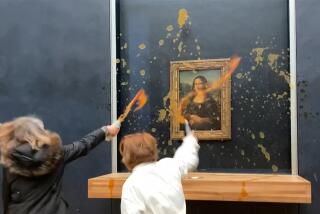NEWS ANALYSIS : Controversial Artists, Art Abandoned? : Arts: NEA chief John E. Frohnmayer apparently steps away from disputed works. At the same time, his no-smut oath for funding is being questioned.
- Share via
WASHINGTON — A pair of subtle developments in the political travails of the National Endowment of the Arts last week illustrate the intensity and risk of the federal arts agency’s struggle for survival.
They involve questions about the willingness of NEA Chairman John E. Frohnmayer to appear to renounce the work of two artists who have been in the vortex of the yearlong arts endowment crisis.
At the same time, some of the NEA’s most visible allies, including Rep. Sidney Yates (D-Ill.), have begun to express concern over Frohnmayer’s decision to require artists and arts groups to execute an acknowledgement of what many construe as an anti-smut loyalty oath to get endowment support.
On two occasions--either occurring or disclosed last week--Frohnmayer has shown he is now willing to engage in an apparent abandonment of the work of the late photographer Robert Mapplethorpe, who died of AIDS last year, and multimedia artist David Wojnarowicz, who has AIDS and has devoted his art to a political and social protest over the plight of its victims.
A Wojnarowicz show, “Tongues of Flame,” has been the most recent focus of controversy after a fundamentalist Christian group and conservative politicians attacked images in it as obscene and sacrilegious.
Since before Frohnmayer’s Senate confirmation last fall, politicians on both of the ideological sides of the NEA controversy, journalists and arts supporters have pressed him to state an opinion on the controversial Mapplethorpe exhibit “The Perfect Moment.” Frohnmayer has been pressed to say if it was artistically meritorious and whether the NEA grant it got was a mistake. Frohnmayer has never committed himself.
But last week, he seemed to abandon both Mapplethorpe and Wojnarowicz. In an April 20 letter to Donald Wildmon, executive director of the American Family Assn., based in Tupelo, Miss., Frohnmayer responded to Wildmon’s objections to Wojnarowicz. The Wildmon group two weeks ago distributed a mailing with severely cropped Wojnarowicz images. The cropped details depicted sexual and religious protest activity.
“The images are disgusting and offensive to me,” Frohnmayer told Wildmon in his letter, which was released by the NEA last week, “and undoubtedly to a large majority of the population. I would hope that, with the procedures I am implementing at the arts endowment, images such as these would not again be funded.”
Then last Thursday, in a contentious television appearance with Wildmon, in which both men traded insults and cast themselves as serving Christianity, the debate turned to Mapplethorpe.
Wildmon demanded to know if Frohnmayer was troubled by the images. “I think that these photos are offensive to many people,” Frohnmayer said. “That’s not something I have funded.”
Unsatisfied, Wildmon pressed on. Would Frohnmayer, he asked, fund Mapplethorpe if the decision had been his? “Would I approve it as it is there?” Frohnmayer responded, gesturing to a prop Wildmon held. “The answer is ‘no.’ ”
Apparent abandonment of the two artists came as Yates and arts supporters question the NEA’s requirement that grant recipients sign a pledge to comply with anti-obscenity language in the endowment’s 1990 funding law.
The requirement has led to decisions by New York theater producer Joseph Papp and Venice choreographer Ferne Ackerman to decline NEA grants. Many arts groups are obliterating the wording or filing protests when they return the signed acknowledgment forms.
But Yates and Washington arts attorney James Fitzpatrick contend the pledge may amount to an anti-obscenity loyalty oath. At a hearing last week, Yates questioned the need for the pledge, noting that other wording in the same form threatens art groups with debarment , a government procedure developed to combat gouging by defense contractors.
Debarred organizations lose their ability to obtain federal grants or contracts from every agency of the government if they are found by any one agency to have violated its procedures or legal strictures. To Yates and Fitzpatrick, though, debarment of artists is especially threatening since an arts organization could get a grant for an exhibit later accused of including a single obscene work--then face the prospect of long-term ineligibility for any additional government support.
“Quite frankly, I thought it important that the arts community know what the law is,” Frohnmayer replied to Yates at the hearing. But to Fitzpatrick and other arts observers, the questions raised by all this have hardly been resolved.
“I don’t know why the NEA added this language,” said Fitzpatrick, who is president of the board of the Washington Project for the Arts--itself a key player in the controversy because it accepted the Mapplethorpe show last year after the Corcoran Gallery of Art here canceled it. “That is not the process that Congress intended,” he said. “It creates more problems than it solves.”
And as to apparently abandoning Mapplethorpe, Fitzpatrick said, “I don’t know on what grounds you could refuse to fund it.” He said Mapplethorpe’s work had been scrutinized by dozens of curators and stands as among the most socially telling--if sometimes viscerally difficult--of its time.
More to Read
The biggest entertainment stories
Get our big stories about Hollywood, film, television, music, arts, culture and more right in your inbox as soon as they publish.
You may occasionally receive promotional content from the Los Angeles Times.










